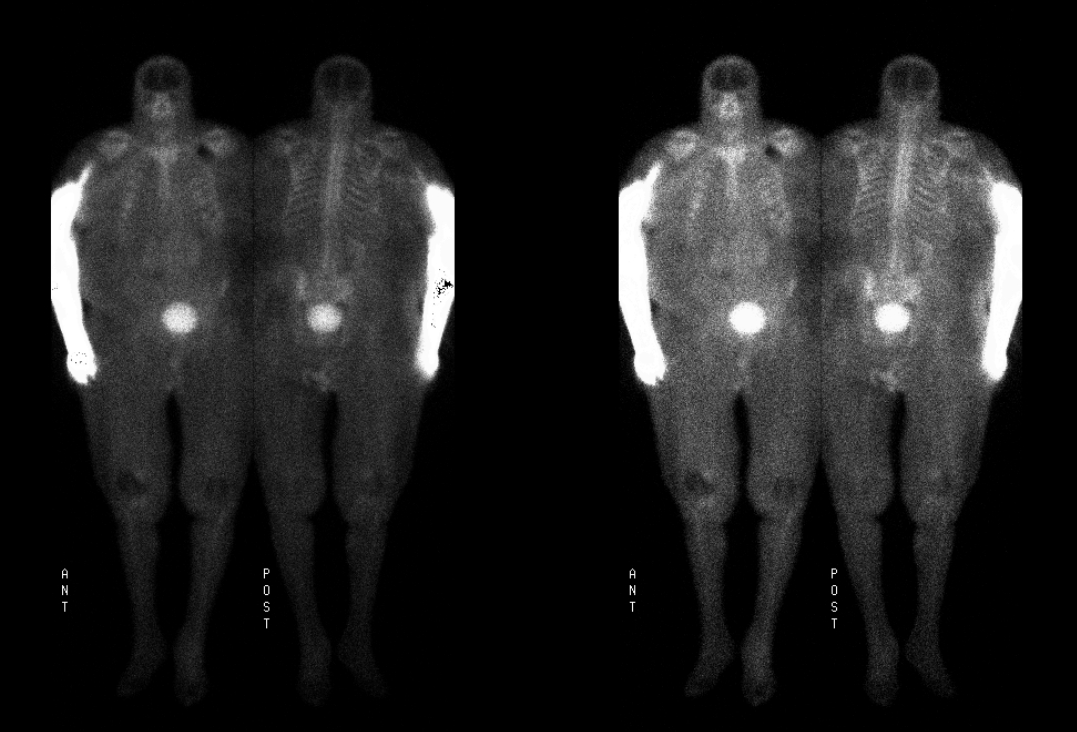Case Author(s): Feiyu Xue, M.D. and Barry A. Siegel, M.D. , 4/8/2004 . Rating: #D2, #Q3
Diagnosis: Infiltration of radiopharmaceutical in soft tissues.
Brief history:
96-year-old woman with a history of back pain.
Images:

Whole-body bone scintigraphy
View main image(bs) in a separate image viewer
Full history/Diagnosis is available below
Diagnosis: Infiltration of radiopharmaceutical in soft tissues.
Full history:
96-year-old woman with a history of osteoporosis and multiple vertebral compression fractures. Bone scintigraphy was requested to evaluate the age of the fractures.
Radiopharmaceutical:
21.1 mCi Tc-99m methylene diphosphonate (MDP) i.v.
Findings:
Delayed whole-body scintigrams demonstrate intense activity in the soft tissues of the right upper extremity. There also is poor skeletal uptake of Tc-99m MDP, as well as diffusely increased soft tissue activity in the rest of the body.
Discussion:
In this patient, the radiopharmaceutical was injected through an existing intravenous line in a distal right forearm vein. The technologist performing the injection noted no abnormal resistance or evidence of extravasation of the injectate. When delayed images were obtained at two hours, there was intense activity in the right upper extremity. Examination of the right forearm intravenous line site at that time showed the right forearm to be edematous due to infiltration of the infused intravenous fluids. The images also show increased soft tissue activity diffusely, reflecting the continued slow input of the tracer to the circulation from the "reservoir" in the right upper extremity soft tissues. There also is relatively decreased activity in the skeleton, as a result of both the incomplete delivery of the injected dose into the circulation and the patient's underlying osteoporosis.
Major teaching point(s):
This is an example of tracer infiltration at the site of injection. Because of the short half life of Tc-99m and its decay by isomeric transition, as well as the diffusibility of Tc-99m MDP, there are no expected long-term consequences. Treatment is the same as that as for regular I.V. fluid infiltration (elevation of the extremity and use of a heating pad to promote increased blood flow in the subcutaneous tissues). On the other hand, infiltration of radiopharmaceuticals, particularly therapeutic radiopharmaceuticals, with longer half-lives or beta emissions, can rarely result in very high local radiation doses and lead to a local radiation injury. This injury, typically a soft tissue ulcer, may not be apparant for weeks. Once the injury becomes evident, it may progress for many months and is difficult to treat. A full thickness skin (and muscle graft) is usually needed for treatment.
Differential Diagnosis List
Diffusely increased soft tissue activity in an upper extremity can also be seen with electrical injury, thermal burns, crush injuries, or infection. A diffusely infiltrating soft tissue tumor with extensive calcification or ossification might have a similar appearance. Intra-arterial injection of Tc-99m MDP shows intensely increased activity in the bones downstream from the arterial injection site.
ACR Codes and Keywords:
References and General Discussion of Bone Scintigraphy (Anatomic field:Skeletal System, Category:Other(Artifact))
Search for similar cases.
Edit this case
Add comments about this case
Return to the Teaching File home page.
Case number: bs138
Copyright by Wash U MO

